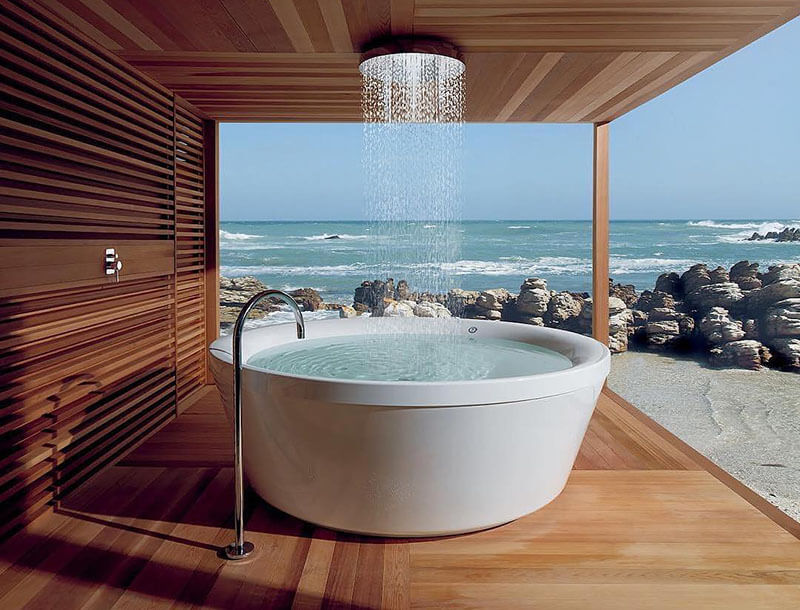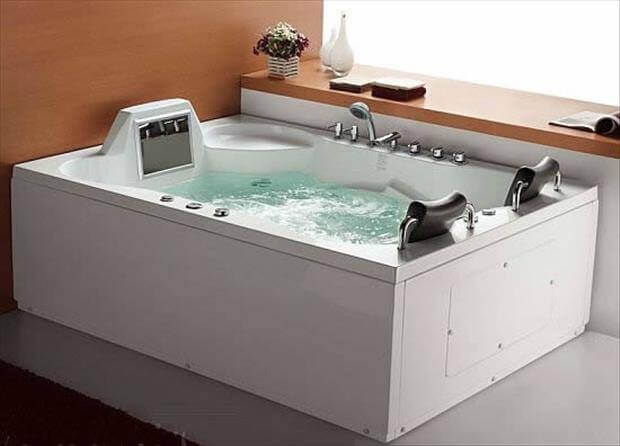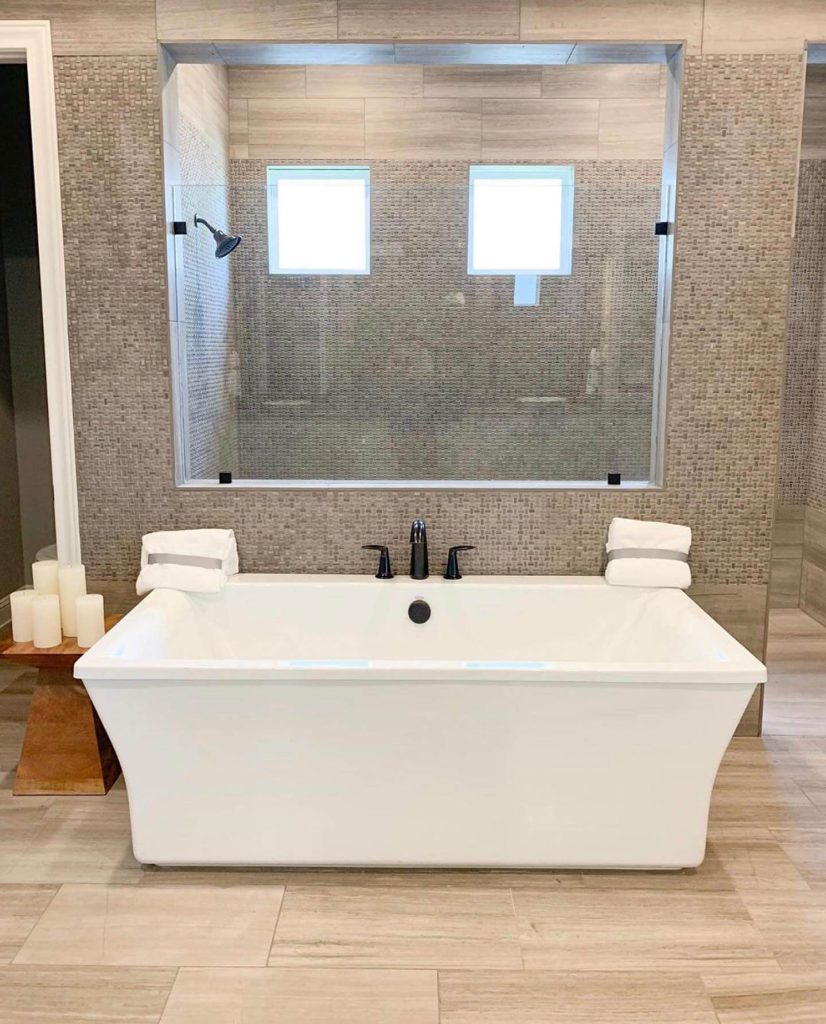Bathtubs might seem uncomfortable for many reasons, such as design issues, poor material, lack of ergonomic support, usage, temperature issues, etc. Most of the time, it’s the design issues that make us feel uncomfortable.
Last summer, my family and I went on a vacation, and trust me when I say that I couldn’t take a single smoothing bath for once during those days. The bathtub lacked ergonomic support, and the overall design was so flawed that it made the bathing experience very uncomfortable.
And that happens to many of us, and my friends shared almost the same experience. That’s why I will try to describe all the possible reasons and how you can make the bathing experience comfortable.

Quick Jump
Reasons Why Bathtubs Can be Uncomfortable
In my over forty years of life, I have lived in over ten houses and used many bathtubs in houses and hotels, and I can’t even count. In my experience, most of them were uncomfortable, and the reasons behind those varied.
I will explain the reasons and causes in this section to help you understand the situation.
Reason #1: Design Issues
Last year, I was in a hotel, using their tub, trying to lean back and unwind. But my back doesn’t quite match the tub’s slope. It’s like trying to fit a square peg into a round hole.
Many tubs are designed with a “one-size-fits-all” mindset, and unfortunately, our bodies just don’t work that way. It might look all ok and fine, but it could be uncomfortable for our body to fit in a tub that’s not designed for that type, and that could be uncomfortable.
Reason #2: Material Impact
If you’ve ever sat on a porcelain or acrylic tub, you’ll know what I’m talking about here. These materials might be durable but are as forgiving as a wood plank. There’s no cushioning, no softness, just cold, hard surfaces.
Nobody wants to nap on a concrete slab, and your back begs for your mercy to find something comfortable.
Reason #3: Lack of Ergonomic Support
As we get older, whether in the office all day or in-home, our body stays in the same place, mostly in a chair. Thank god I found an Ergonomic Chair which helps me with back pain and all, and now I understand the need for ergonomically designed furniture or things we use daily.
In this case, most tubs lack proper ergonomic support, and you’re left to fend for yourself, trying to find that elusive comfy position while your neck cranes and your spine rebels.
Reason #4: Duration of Use
You might have noticed occasionally that there is not much discomfort when you’re taking quick showers. But, while taking long soaks, that’s where the discomfort party gets going.
Our bodies aren’t meant to sit in one position for ages, and bathtubs don’t have the magic touch to change that.
Reason #5: Temperature Challenges
It happened to me many times, and if you can relate, you will know that sometimes the bath temperature gets down too quickly.
You can’t blame it because bathtubs aren’t exactly known for their insulation skills, so that water you just lovingly heated up starts cooling down faster.
Reason #6: Accessibility
Whether you have mobility issues or not, imagine someone with mobility issues is trying to get in and out of a bathtub.
For people with disabilities, the lack of accessibility can be a real downer. It’s like trying to climb Mount Everest, and it’s difficult and uncomfortable.
Why Does My Bathtub Feel Rough?

Your bathtub might feel rough because of wear and tear, mineral buildup, abrasive cleaning, and age-related deterioration. Whatever the reason is, you won’t feel comfortable taking a bath there, that’s for sure.
Over time, the constant flow of water, soap, and, yes, even those luxurious bath bombs can cause tiny abrasions on the surface of your bathtub. Think of it as a million gentle paper cuts that, when combined, give you that not-so-smooth feeling.
If you live in an area with hard water, those minerals can also build up on your bathtub’s surface, creating a rough texture that’s not spa-worthy.
Sometimes, our over-enthusiastic cleaning efforts can backfire. I have used abrasive cleaners for the last few years and scrubbed vigorously with rough sponges. As a result, all those wear down the bathtub’s surface, making it lose its smoothness and become rough.
Last but not least, constant exposure to water, temperature changes, and everyday use can contribute to the gradual deterioration of the bathtub’s surface, leading to that rough feeling.
How Can I Be Comfortable In the Bathtub?

I discussed all the possible reasons that can make you uncomfortable in your bathtub, which might feel rough. As I mentioned, you could feel uncomfortable in your bathtub for multiple reasons.
Now, there are solutions or tricks for them which might make things a bit better so that you feel comfortable. I will try to discuss and share those with you, and you might be able to take a relaxing bath in your bathtub.
Solution #1: Bathtubs with Adjustable Features
If the issue is strictly related to design, you might need to get rid of the old one if there are not many customization options. Besides that, there are a few things that you might need to keep in mind. I noted them down for you.
- You want a tub that supports your natural posture, so you should look for tubs with adjustable backrests that allow you to find the sweet spot that cradles your back perfectly.
- A too-narrow tub might leave you feeling cramped, while one too wide could make it hard to reach the soap or faucet comfortably. Opt for a tub that strikes the right balance between width and depth, providing ample space to stretch.
- Arm and neck support in the bathtub are crucially important. Look for tubs with contoured edges that provide a natural resting place for your arms and a supportive neck area.
- Some tubs come with built-in seats, which can be a game-changer if you’re not a fan of the full-on recline. Make sure the seat’s shape and height suit your preferences.
- Another important thing to remember is a textured bottom or built-in grips to ensure you can move around safely without worrying about slipping and sliding.
Besides, everyone’s body is unique, and you need to look for a tub that fits your and your family member’s size. Many tubs from brands offer customization options, allowing you to tweak the design to match your body’s curves and contours.
Here is a table to help you understand.
| Body Size | Length (inches) | Width (inches) | Depth (inches) | Recommended |
| Petite (5’0″ and under) | 54 – 60 | 28 – 32 | 14 – 18 | Small to Medium Soaking Tub |
| Average (5’1″ – 5’7″) | 60 – 66 | 30 – 34 | 15 – 19 | Standard Soaking Tub |
| Tall (5’8″ and above) | 66 – 72 | 32 – 36 | 16 – 20 | Large Soaking Tub |
Solution #2: Softer Materials
Harder material is another reason, and finding a tub with softer material is the obvious solution. You need to look for tubs with smoother and less rigid surfaces, and materials like acrylic or fiberglass are more comfortable than harder options like porcelain or stone.
Besides, tubs with good insulation help maintain water temperature for longer, so you can enjoy your soak without feeling like you’re slowly turning into an icicle. And, Some manufacturers offer tubs with built-in foam or gel cushioning, creating a softer and more comfortable bathing experience.
That’s not all because you must choose materials that naturally retaining heat, like copper, which can retain warmth and keep your bathwater comfortable without excessive hot water top-ups.
Solution #3: Usage & Ergonomic Features
Although it is directly connected to design, the importance of ergonomic features made me write a different section about it. I used so many tubs that were so uncomfortable just because those lacked ergonomic support.
That’s why you need to see some features while looking for a bathtub.
- Keep an eye out for models that feature contoured shapes that mimic your body’s natural curves, offering support where you need it most – like your neck, back, and arms.
- Bathtubs that come with built-in headrests are a lifesaver.
- Besides, tub designs that include armrests and side ledges are a win-win.
- You will find many bathtubs that are certified for their ergonomic design. Certain manufacturers go the extra mile to ensure their products meet ergonomic standards.
Solution #4: Temperature Control Features
If you want to transform your bathtub experience into a cozy haven, there are a few things you must have in your bathtub.
- You will find some materials, like high-density foam or advanced insulating layers, in the bathtubs that keep the water warmer for longer.
- Bathtubs with double-walled construction provide an added barrier against heat loss.
- Cast iron and some acrylics have superior heat retention properties.
- A larger water heater can ensure a more consistent, longer-lasting hot water supply, providing a comfortable bathing experience.
- Believe it or not, the design of the overflow and drain can impact temperature control.
- Consider investing in accessories like bath covers or thermal blankets designed for bathtubs.
Solution #5: Accessibility Options
Regarding accessibility issues, there are so many things to think about. It’s not easy for us to go through this, whether it’s one of our family members or you, even if you’re in a hotel for the vacation.
- With innovation and design superiority, there are bathtubs with a door that swings open, allowing you to step right in without any hassle.
- A low step or threshold is essential for easy access.
- A walk-in tub with built-in seating lets you sit down comfortably and enjoy your bath without the struggle.
- Ensure the tub has strategically placed grab bars you can hold onto while getting in, sitting down, and standing up.
- If you need to adjust the water temperature or jets, ensure the controls are within arm’s reach.
These are more or less the solutions I know of, but there could be others, and there are. But these are the major issues you might face that make your bath experience uncomfortable. And I tried to provide as many solutions as I could.
How Do I Make My Bathtub Smooth?

You can make your bathtub smooth by using a cleaner, buffing away imperfections, sandpaper, and a protective wax coating. These can smooth your bathtub and give you the perfect bathing experience you long for.
I will just go over those tips step-by-step briefly.
Step #1: Use a mild bathroom cleaner or a mixture of baking soda and water to clean the surface gently. For those stubborn spots, a bit of white vinegar does wonders. Don’t forget the nooks and crannies – a soft-bristle toothbrush works wonders for those hard-to-reach areas.
Step #2: A car polish or a specialized tub refinishing kit can work like magic for minor scratches and dullness. You might need to apply the polish with a soft cloth and buff in circular motions until you see that beautiful shine.
Step #3: You can lightly sand the surface for deeper scratches or rough patches. Grab some fine-grit sandpaper (around 600 to 800 grit) and wet it with soapy water. Gently sand the affected areas in a circular motion until they’re smooth and flush with the rest of the tub.
Step #4: Choose a non-abrasive car wax and apply a thin, even layer to the entire tub. Let it dry to a hazy finish, then buff it off with a clean cloth.
And that’s it. Your bathtub is even smoother than before.
Wrap Up
It is the part where I say my goodbyes for now because I think I covered all the topics, possible reasons, and solutions for those. Hopefully, those will help you understand the issues with your uncomfortable bathing experience and bathtubs.
If there is anything else you want to know regarding the topic, feel free to let me know. Have a great weekend!

Chino is an accomplished Founder and Home Improvement Contractor with a passion for transforming living spaces into beautiful, functional, and comfortable homes. With years of experience in the industry, he has established himself as a reputable expert in the field, earning the trust and admiration of numerous clients.
